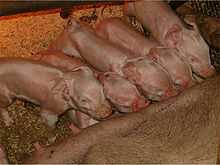Savaging

Savaging is a term used in ethology which refers to mother animals attacking their new-born offspring, sometimes fatally. The behaviour occurs particularly in domestic pigs (Sus scrofa domesticus); it is more frequent in gilts than in second or later parity sows.[1] Some attacks on newborn piglets are non-fatal. Others may cause the death of the piglets and sometimes, the mother may eat the piglets. It is estimated that 50% of piglet fatalities are due to the mother attacking, or unintentionally crushing, the newborn pre-weaned animals.[2]
Savaging behavior impacts yields from pig farming. Efforts to eliminate the behavior include additional care and attention for the mother pig. Aggressive behavior may be due to fear, discomfort, and unsanitary conditions.[2] Control of the birthing process and human supervision are the best ways to prevent the mother from eating the young.
Anecdotal reports indicate that once mother pigs have cannibalised their young, this may happen again. Therefore, one approach to reduce savinging is to avoid using mothers that have savaged their young for breeding. Alternatively, placing experienced sows next to first-time mother gilts may discourage savaging.
Proper diet and nutrition decreases the likelihood of gilt cannibalism. Medication or hormones, such as mysoline, can also be given.
Pigs will sometimes attack other animals, including humans.[3]
See also
Notes
- ↑ Harris, M., Bergeron, R., Li1, Y. and Gonyou, H. (2001). "Savaging of piglets: A puzzle of maternal behaviour" (PDF). Retrieved July 31, 2013.
- ↑ 2.0 2.1 North Carolina Pork Conference – Management Tips to Reduce Pre-Weaning Mortality. 2002. North Carolina State University.
- ↑ Daily Mail article: Nurse 'savaged' by enraged giant pig. 13 October 2006
External links
- Prairie Swine 2001 article about savaging.
- Description and details at ThePigSite.com